Randomized Tensor Wheel Decomposition
IF 2.6
2区 数学
Q1 MATHEMATICS, APPLIED
引用次数: 0
Abstract
SIAM Journal on Scientific Computing, Volume 46, Issue 3, Page A1714-A1746, June 2024.Abstract. Tensor wheel (TW) decomposition is an elegant compromise of the popular tensor ring decomposition and fully connected tensor network decomposition, and it has many applications. In this work, we investigate the computation of this decomposition. Three randomized algorithms based on random sampling or random projection are proposed. Specifically, by defining a new tensor product called the subwheel product, the structures of the coefficient matrices of the alternating least squares subproblems from the minimization problem of TW decomposition are first figured out. Then, using the structures and the properties of the subwheel product, a random sampling algorithm based on leverage sampling and two random projection algorithms respectively based on Kronecker subsampled randomized Fourier transform and TensorSketch are derived. These algorithms can implement the sampling and projection on TW factors and hence can avoid forming the full coefficient matrices of subproblems. We present the complexity analysis and numerical performance on synthetic data, real data, and image reconstruction for our algorithms. Experimental results show that, compared with the deterministic algorithm in the literature, they need much less computing time while achieving similar accuracy and reconstruction effect. We also apply the proposed algorithms to tensor completion and find that the sampling-based algorithm always has excellent performance and the projection-based algorithms behave well when the sampling rate is higher than 50%.
随机张轮式分解
SIAM 科学计算期刊》,第 46 卷第 3 期,第 A1714-A1746 页,2024 年 6 月。 摘要张量轮(TW)分解是流行的张量环分解和全连接张量网络分解的优雅折衷,它有很多应用。在这项工作中,我们研究了这种分解的计算方法。我们提出了三种基于随机抽样或随机投影的随机算法。具体地说,通过定义一种新的张量乘积--子轮乘积,首先找出了 TW 分解最小化问题中交替最小二乘子问题的系数矩阵结构。然后,利用子轮积的结构和性质,分别推导出基于杠杆采样的随机采样算法和基于克朗内克子采样随机傅里叶变换和 TensorSketch 的两种随机投影算法。这些算法可以在 TW 因子上实现采样和投影,从而避免形成子问题的全系数矩阵。我们介绍了我们的算法在合成数据、真实数据和图像重建方面的复杂性分析和数值性能。实验结果表明,与文献中的确定性算法相比,它们所需的计算时间要少得多,却能达到相似的精度和重建效果。我们还将提出的算法应用于张量补全,发现当采样率高于 50%时,基于采样的算法始终具有出色的性能,而基于投影的算法则表现良好。
本文章由计算机程序翻译,如有差异,请以英文原文为准。
求助全文
约1分钟内获得全文
求助全文
来源期刊
CiteScore
5.50
自引率
3.20%
发文量
209
审稿时长
1 months
期刊介绍:
The purpose of SIAM Journal on Scientific Computing (SISC) is to advance computational methods for solving scientific and engineering problems.
SISC papers are classified into three categories:
1. Methods and Algorithms for Scientific Computing: Papers in this category may include theoretical analysis, provided that the relevance to applications in science and engineering is demonstrated. They should contain meaningful computational results and theoretical results or strong heuristics supporting the performance of new algorithms.
2. Computational Methods in Science and Engineering: Papers in this section will typically describe novel methodologies for solving a specific problem in computational science or engineering. They should contain enough information about the application to orient other computational scientists but should omit details of interest mainly to the applications specialist.
3. Software and High-Performance Computing: Papers in this category should concern the novel design and development of computational methods and high-quality software, parallel algorithms, high-performance computing issues, new architectures, data analysis, or visualization. The primary focus should be on computational methods that have potentially large impact for an important class of scientific or engineering problems.

 求助内容:
求助内容: 应助结果提醒方式:
应助结果提醒方式:


